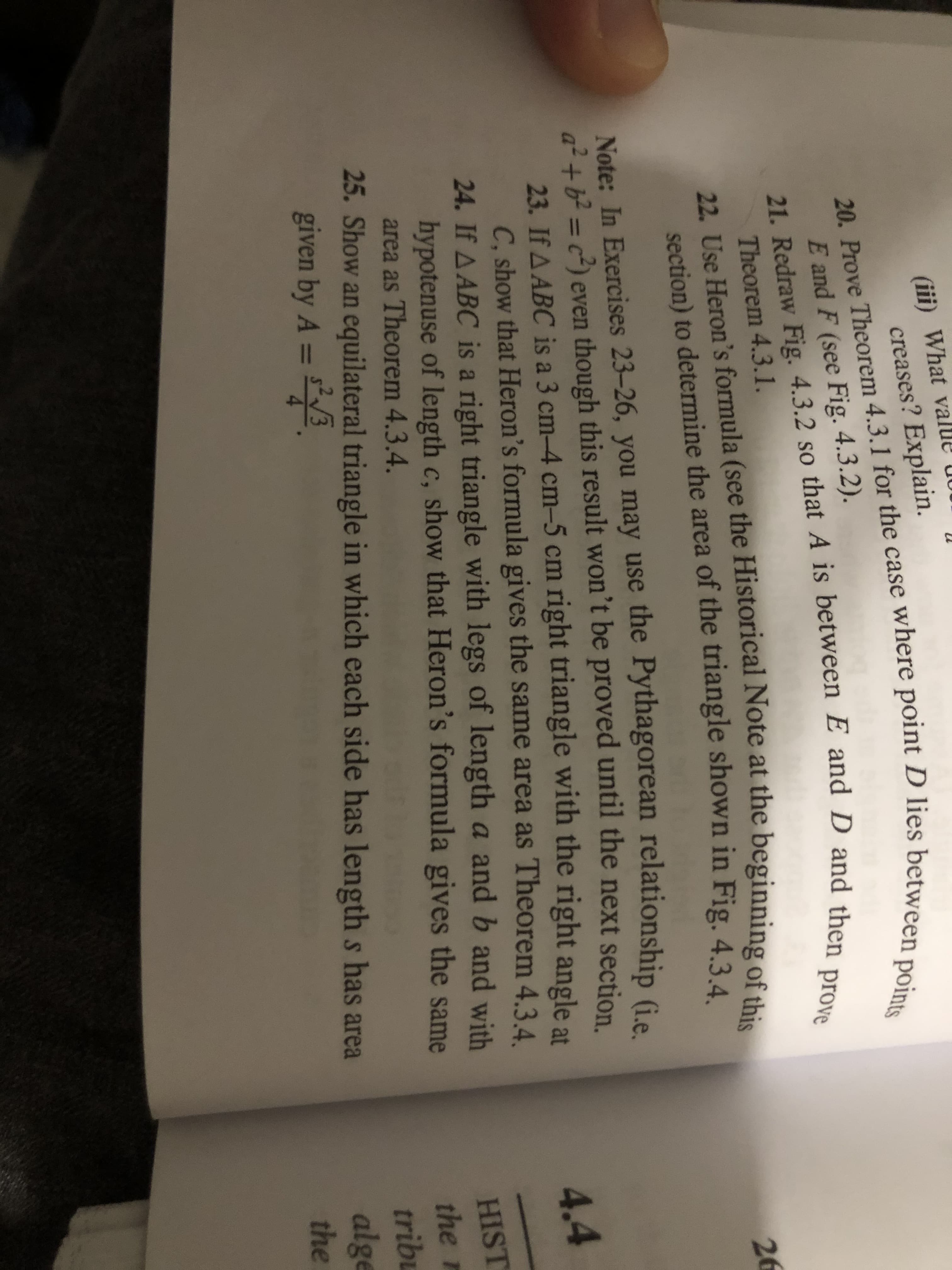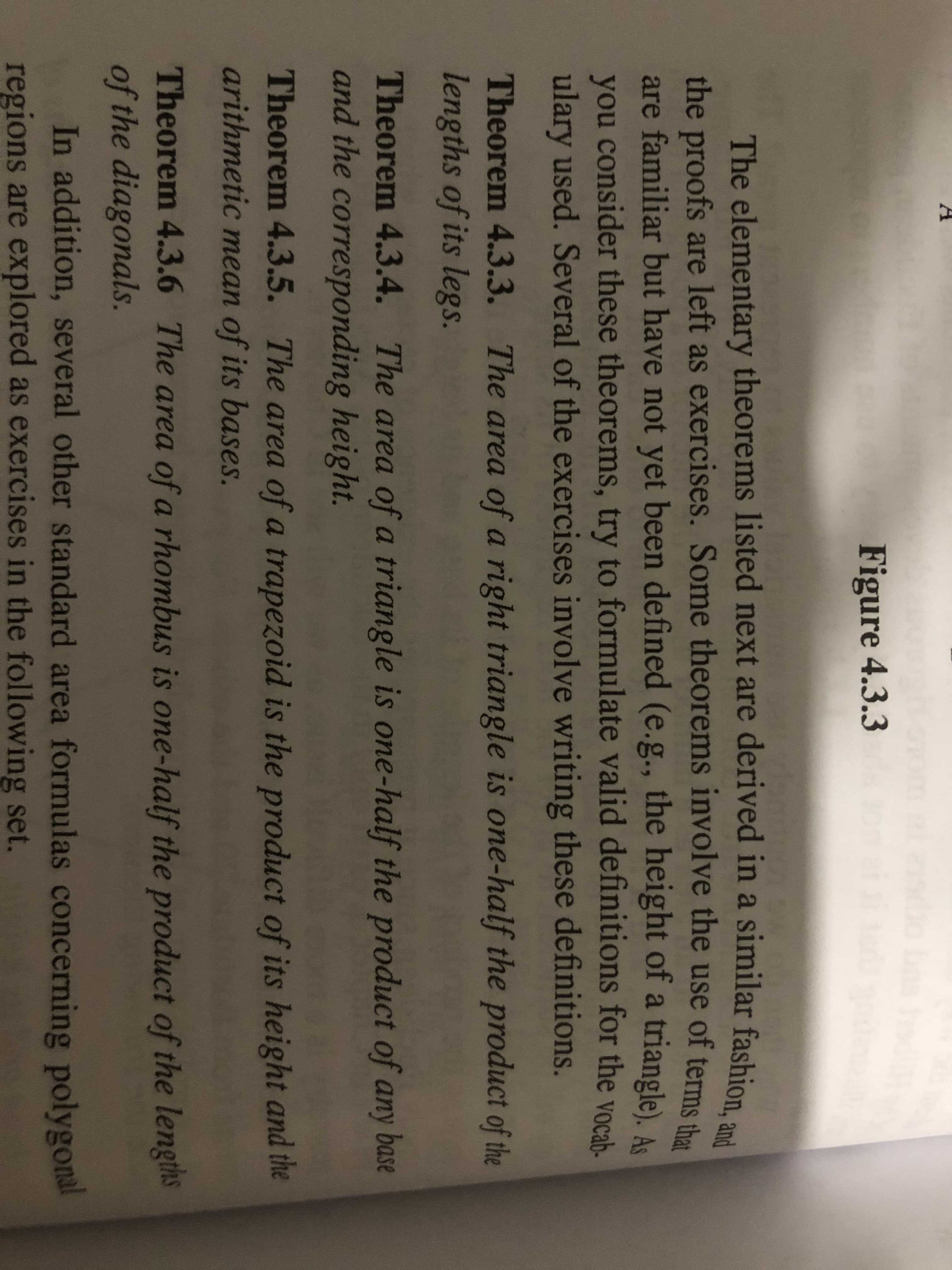(iii) What valu creases? Explain. 20. Prove Theorem 4.3.1 for the case where point D lies between points 21. Redraw Fig. 4.3.2 so that A is between E and D and then prove 22. Use Heron's formula (see the Historical Note at the beginning of this E and F (see Fig. 4.3.2). Theorem 4.3.1. section) to determine the area of the triangle shown in Fig. 4.3.4. 26 Note: In Exercises 23-26, you may use the Pythagorean relationship (i.e. a2+b2=c2) even though this result won't be proved until the next section 23. If A ABC is a 3 cm-4 cm-5 cm right triangle with the right angle at C. show that Heron's formula gives the same area as Theorem 4.3.4 24. If A ABC is a right triangle with legs of length a and b and with hypotenuse of length c, show that Heron's formula gives the same area as Theorem 4.3.4. 25. Show an equilateral triangle in which each side has length s has area 4.4 HIST the r tribu given by A - 3 alge the Figure 4.3.3 The elementary theorems listed next are derived in a similar fashion the proofs are left as exercises. Some theorems involve the use of terms he are familiar but have not yet been defined (e.g., the height of a triangle), As you consider these theorems, try to formulate valid definitions for the vocah. ulary used. Several of the exercises involve writing these definitions. Theorem 4.3.3. The area ofa right triangle is one-half the product of the lengths of its legs. Theorem 4.3.4. The area of a triangle is one-half the product of any base and the corresponding height. Theorem 4.3.5. The area of a trapezoid is the product of its height and the arithmetic mean of its bases. Theorem 4.3.6 The area of a rhombus is one-half the product of the lengths of the diagonals. In addition, several other standard area formulas concerning polygonal regions are explored as exercises in the following set.
(iii) What valu creases? Explain. 20. Prove Theorem 4.3.1 for the case where point D lies between points 21. Redraw Fig. 4.3.2 so that A is between E and D and then prove 22. Use Heron's formula (see the Historical Note at the beginning of this E and F (see Fig. 4.3.2). Theorem 4.3.1. section) to determine the area of the triangle shown in Fig. 4.3.4. 26 Note: In Exercises 23-26, you may use the Pythagorean relationship (i.e. a2+b2=c2) even though this result won't be proved until the next section 23. If A ABC is a 3 cm-4 cm-5 cm right triangle with the right angle at C. show that Heron's formula gives the same area as Theorem 4.3.4 24. If A ABC is a right triangle with legs of length a and b and with hypotenuse of length c, show that Heron's formula gives the same area as Theorem 4.3.4. 25. Show an equilateral triangle in which each side has length s has area 4.4 HIST the r tribu given by A - 3 alge the Figure 4.3.3 The elementary theorems listed next are derived in a similar fashion the proofs are left as exercises. Some theorems involve the use of terms he are familiar but have not yet been defined (e.g., the height of a triangle), As you consider these theorems, try to formulate valid definitions for the vocah. ulary used. Several of the exercises involve writing these definitions. Theorem 4.3.3. The area ofa right triangle is one-half the product of the lengths of its legs. Theorem 4.3.4. The area of a triangle is one-half the product of any base and the corresponding height. Theorem 4.3.5. The area of a trapezoid is the product of its height and the arithmetic mean of its bases. Theorem 4.3.6 The area of a rhombus is one-half the product of the lengths of the diagonals. In addition, several other standard area formulas concerning polygonal regions are explored as exercises in the following set.
Algebra & Trigonometry with Analytic Geometry
13th Edition
ISBN:9781133382119
Author:Swokowski
Publisher:Swokowski
Chapter4: Polynomial And Rational Functions
Section4.3: Zeros Of Polynomials
Problem 67E
Related questions
Concept explainers
Contingency Table
A contingency table can be defined as the visual representation of the relationship between two or more categorical variables that can be evaluated and registered. It is a categorical version of the scatterplot, which is used to investigate the linear relationship between two variables. A contingency table is indeed a type of frequency distribution table that displays two variables at the same time.
Binomial Distribution
Binomial is an algebraic expression of the sum or the difference of two terms. Before knowing about binomial distribution, we must know about the binomial theorem.
Topic Video
Question
24

Transcribed Image Text:(iii) What valu
creases? Explain.
20. Prove Theorem 4.3.1 for the case where point D lies between points
21. Redraw Fig. 4.3.2 so that A is between E and D and then prove
22. Use Heron's formula (see the Historical Note at the beginning of this
E and F (see Fig. 4.3.2).
Theorem 4.3.1.
section) to determine the area of the triangle shown in Fig. 4.3.4.
26
Note: In Exercises 23-26, you may use the Pythagorean relationship (i.e.
a2+b2=c2) even though this result won't be proved until the next section
23. If A ABC is a 3 cm-4 cm-5 cm right triangle with the right angle at
C. show that Heron's formula gives the same area as Theorem 4.3.4
24. If A ABC is a right triangle with legs of length a and b and with
hypotenuse of length c, show that Heron's formula gives the same
area as Theorem 4.3.4.
25. Show an equilateral triangle in which each side has length s has area
4.4
HIST
the r
tribu
given by A - 3
alge
the

Transcribed Image Text:Figure 4.3.3
The elementary theorems listed next are derived in a similar fashion
the proofs are left as exercises. Some theorems involve the use of terms he
are familiar but have not yet been defined (e.g., the height of a triangle), As
you consider these theorems, try to formulate valid definitions for the vocah.
ulary used. Several of the exercises involve writing these definitions.
Theorem 4.3.3. The area ofa right triangle is one-half the product of the
lengths of its legs.
Theorem 4.3.4. The area of a triangle is one-half the product of any base
and the corresponding height.
Theorem 4.3.5. The area of a trapezoid is the product of its height and the
arithmetic mean of its bases.
Theorem 4.3.6 The area of a rhombus is one-half the product of the lengths
of the diagonals.
In addition, several other standard area formulas concerning polygonal
regions are explored as exercises in the following set.
Expert Solution
This question has been solved!
Explore an expertly crafted, step-by-step solution for a thorough understanding of key concepts.
This is a popular solution!
Trending now
This is a popular solution!
Step by step
Solved in 4 steps with 3 images

Knowledge Booster
Learn more about
Need a deep-dive on the concept behind this application? Look no further. Learn more about this topic, advanced-math and related others by exploring similar questions and additional content below.Recommended textbooks for you

Algebra & Trigonometry with Analytic Geometry
Algebra
ISBN:
9781133382119
Author:
Swokowski
Publisher:
Cengage

Mathematics For Machine Technology
Advanced Math
ISBN:
9781337798310
Author:
Peterson, John.
Publisher:
Cengage Learning,

Elementary Geometry for College Students
Geometry
ISBN:
9781285195698
Author:
Daniel C. Alexander, Geralyn M. Koeberlein
Publisher:
Cengage Learning

Algebra & Trigonometry with Analytic Geometry
Algebra
ISBN:
9781133382119
Author:
Swokowski
Publisher:
Cengage

Mathematics For Machine Technology
Advanced Math
ISBN:
9781337798310
Author:
Peterson, John.
Publisher:
Cengage Learning,

Elementary Geometry for College Students
Geometry
ISBN:
9781285195698
Author:
Daniel C. Alexander, Geralyn M. Koeberlein
Publisher:
Cengage Learning

Elementary Geometry For College Students, 7e
Geometry
ISBN:
9781337614085
Author:
Alexander, Daniel C.; Koeberlein, Geralyn M.
Publisher:
Cengage,

Linear Algebra: A Modern Introduction
Algebra
ISBN:
9781285463247
Author:
David Poole
Publisher:
Cengage Learning